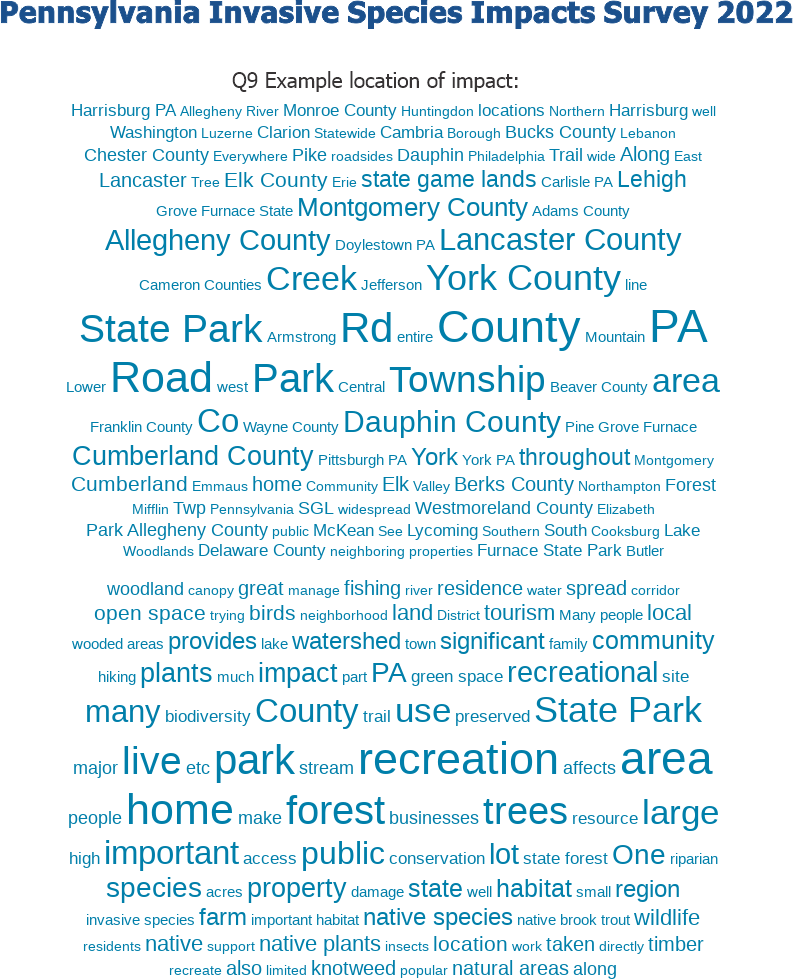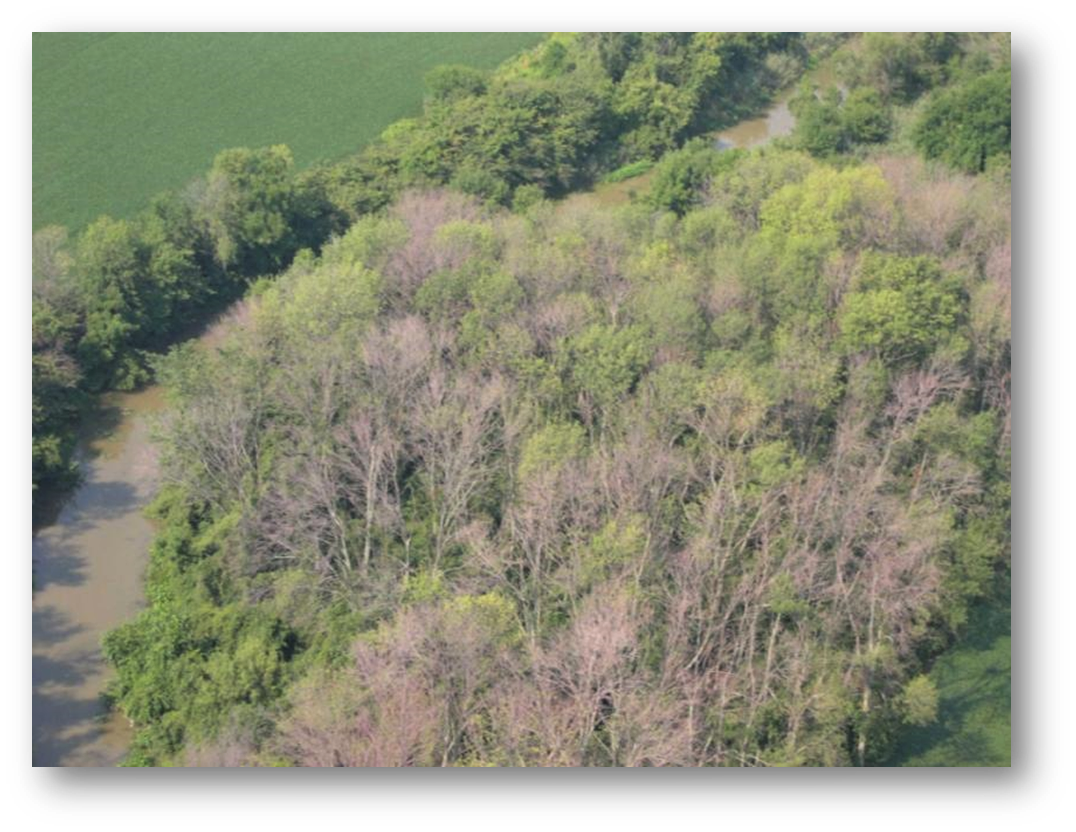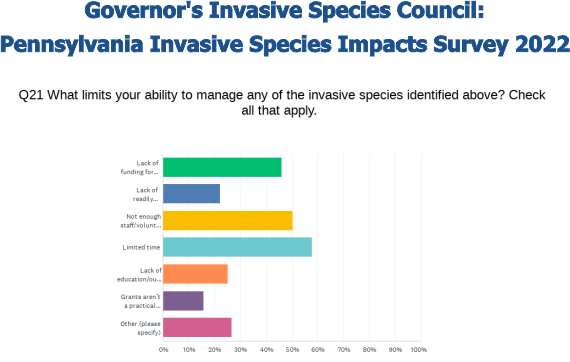Pennsylvania Invasive Species Impacts Survey 2022
The Governor's Invasive Species Council conducted the first statewide Pennsylvania Invasive Species Impacts Survey in fall 2022.
The purpose was to hear directly from Pennsylvanians about the economic, environmental, and personal impacts they're experiencing from invasive plants, insects, pathogens, and animals. In addition, the survey documented what Pennsylvanians are doing to remove invasive species, including spending their own money out of pocket.
Every county was represented in the survey. While conservation and outdoor recreation professionals and advocates were the majority of respondents, many local government officials, transportation personnel, farmers, educators, homeowners, industry professionals, vineyard owners, and others took the survey.
Press release: "Governor's Invasive Species Council Shares Results of First Statewide Invasive Impacts Survey, Announces Pilot Management Program," 3/13/23
Results
Invasive species are proliferating in all parts of Pennsylvania.
Invasive species are a problem in all parts of Pennsylvania, rural, urban, and suburban, and in land and water natural areas around the state. Over 1,000 survey participants reported where they're contending with invasives.
Sampling of responses:

Invasive species are having many damaging impacts.
Over 600 Pennsylvanians described 1,480 negative impacts from one to three invasive species. See a sampling.
Examples of general types of damage reported:
- Constricted access to lakes, trails, and community parks.
- Lost timber product.
- Severely hampered forest regrowth, causing economic loss, loss of wildlife habitat, and loss of Pennsylvania's forest heritage.
- Damaged grapevines, fruit trees, and nursery stock.
- Takeover of wetlands and streambank plantings, impairing the flood control, water filtration, and habitat functions of these types of green infrastructure.
- Loss of biodiversity, and the decline of Pennsylvania native brook trout, crayfish, eastern hemlock tree, and other native species.
- Safety hazards from dead ash trees along roads and in communities.
- Reduced sightlines on the road from the proliferation of roadside invasive shrubs.
Respondents cited over 100 different invasive plants, trees, shrubs, pathogens, insects, and fish. They included spotted lanternfly, mile-a-minute vine, Japanese stiltgrass, barberry shrubs, zebra mussels, and many others.
Emerald ash borer was among the species reported most often. Since this beetle hit Pennsylvania in 2007, it has since destroyed thousands of ash trees, a mainstay of the timber industry.

Ash trees killed by emerald ash borer in Pennsylvania.
(Photo courtesy of PA Department of Conservation and Natural Resources)
Trying to reduce invasive species individually is a costly losing battle.
Over 650 people said they're trying to manage invasive species on their own, often spending their own funds, and are frustrated at not winning the battle.

While limited funds and staff and volunteer resources are major obstacles, time is the biggest obstacle, as invasive species proliferate unchecked, because of the absence of natural predators and other factors.
Responses from a few companies currently providing invasive species management services suggest the potential for economic opportunity and job creation.
Many participants would like a statewide framework to manage and reduce invasive species regionally.
The Governor's Invasive Species Council proposes that a Partnerships for Regional Invasive Species Management (PRISM) framework be permanently established and funded to enable statewide invasive species management in a way that's flexible to address regional priorities and allow regional solutions.
- Over 350 participants said a PRISM program would help, because it would provide dedicated locally based resources. Over 200 others were interested in learning more about PRISM.
- Over 380 participants want to participate in a PRISM in their region.
Case study: Mark Fajerski, tree farmer, Maple Hills Tree Farm, Washington County
Invasive species he's contending with: Emerald ash borer, spongy moth, mile-a-minute, honeysuckle vine and bush, multiflora rose, olive, oriental bittersweet, Japanese stilt grass, Japanese barberry, and privet
Impacts he's seeing: "The invasive plants crowd out native plants - impedes reproduction. Barberry promotes the tick population. Emerald ash borer has decimated my white ash. The negative environmental impact is impossible to quantitate. White ash may be functionally extinct."
What's limited his ability to reduce invasives: Lack of funding for equipment, supplies, or labor; lack of readily accessible technical expertise; not enough staff/volunteer personnel to work on the ground; limited time
Whether a PRISM program would help: "Yes, because invasives are extensive and too much for one person to handle."